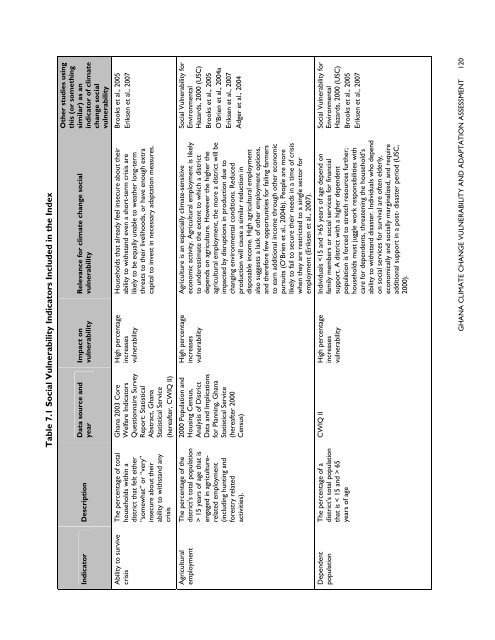ghana climate change vulnerability and adaptation assessment
ghana climate change vulnerability and adaptation assessment
ghana climate change vulnerability and adaptation assessment
- No tags were found...
You also want an ePaper? Increase the reach of your titles
YUMPU automatically turns print PDFs into web optimized ePapers that Google loves.
Indicator DescriptionAbility to survivecrisisThe percentage of totalhouseholds within adistrict that felt either“somewhat” or “very”insecure about theirability to withst<strong>and</strong> anycrisisAgriculturalemploymentThe percentage of thedistrict’s total population> 15 years of age that isengaged in agriculturerelatedemployment(including hunting <strong>and</strong>forestry relatedactivities).DependentpopulationThe percentage of adistrict’s total populationthat is < 15 <strong>and</strong> > 65years of ageTable 7.1 Social Vulnerability Indicators Included in the IndexData source <strong>and</strong>yearGhana 2003 CoreWelfare IndicatorsQuestionnaire SurveyReport: StatisticalAbstract, GhanaStatistical Service(hereafter, CWIQ II)2000 Population <strong>and</strong>Housing Census,Analysis of DistrictData <strong>and</strong> Implicationsfor Planning, GhanaStatistical Service(hereafter 2000Census)Impact on<strong>vulnerability</strong>High percentageincreases<strong>vulnerability</strong>High percentageincreases<strong>vulnerability</strong>CWIQ II High percentageincreases<strong>vulnerability</strong>Relevance for <strong>climate</strong> <strong>change</strong> social<strong>vulnerability</strong>Households that already feel insecure about theirability to withst<strong>and</strong> even a short-term crisis arelikely to be equally unable to weather long-termthreats to their livelihoods, or have enough extracapital to invest in necessary <strong>adaptation</strong> measures.Agriculture is an especially <strong>climate</strong>-sensitiveeconomic activity. Agricultural employment is likelyto underestimate the extent to which a districtdepends on agriculture. However the higher theagricultural employment, the more a district will beimpacted by disruptions in production due tochanging environmental conditions. Reducedproduction will cause a similar reduction indisposable income. High agricultural employmentalso suggests a lack of other employment options,<strong>and</strong> therefore few opportunities for failing farmersto earn additional income through other economicpursuits (O’Brien et al., 2004b). People are morelikely to fail to secure their needs in a time of crisiswhen they are restricted to a single sector foremployment (Eriksen et al., 2007).Individuals 65 years of age depend onfamily members or social services for financialsupport. A district with a higher dependentpopulation is forced to stretch resources further;households must juggle work responsibilities withcare for dependents, threatening the household’sability to withst<strong>and</strong> disaster. Individuals who dependon social services for survival are often elderly,economically <strong>and</strong> socially marginalized, <strong>and</strong> requireadditional support in a post- disaster period (USC,2000).Other studies usingthis (or somethingsimilar) as anindicator of <strong>climate</strong><strong>change</strong> social<strong>vulnerability</strong>Brooks et al., 2005Eriksen et al., 2007Social Vulnerability forEnvironmentalHazards, 2000 (USC)Brooks et al., 2005O’Brien et al., 2004aEriksen et al., 2007Adger et al., 2004Social Vulnerability forEnvironmentalHazards, 2000 (USC)Brooks et al., 2005Eriksen et al., 2007GHANA CLIMATE CHANGE VULNERABILITY AND ADAPTATION ASSESSMENT 120
















